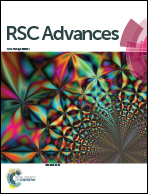Effects of sulfur compounds on the hydrogenation and isomerization of 1-hexene over a sulfided CoMo catalyst for hydrodesulfurization†
Abstract
The transformation of olefins is crucial to the hydrodesulfurization (HDS) of fluid catalytic cracking (FCC) gasoline. The reactivity of 1-hexene was studied over a sulfided CoMo/Al2O3 catalyst. Effects of hydrogen sulfide (H2S) and three organic sulfur compounds on 1-hexene transformation were also investigated. As for the hydroconversion of 1-hexene, the double-bond isomerization (ISOM) of 1-hexene proceeded readily at lower temperatures while the hydrogenation (HYD) of 1-hexene and its isomers predominated at higher temperatures. The inhibiting effect of H2S on both isomerization and hydrogenation reactions resulted in the decline in 1-hexene HYD conversion. The saturation rate of 1-hexene increased sharply when H2S content decreased to below 100 μg g−1 S. It was also found that thiophene (T), 2-methylthiophene (2MT) and 3-methylthiophene (3MT) strongly inhibited the hydrogenation of 1-hexene. Furthermore, the inhibiting effect on 1-hexene HYD reaction originated from H2S generated by organic sulfide desulfurization. More isomerization products were obtained in the presence of sulfur compounds, probably attributable to the inhibition of sulfur compounds on the hydrogenation of 1-hexene and its isomers.


 Please wait while we load your content...
Please wait while we load your content...